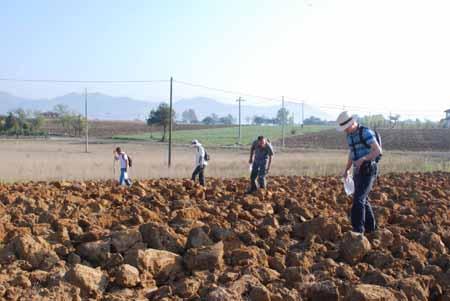Welcome to the Roman Colonial Landscapes project!
The project ran in 2010-12 and is now FINISHED. These pages have now been archived (as such thay have not been updated since 2012) and they provide general information about the project as well as our preliminary annual reports.
If you are interested in the current archaeological fieldwork project,
please click HERE.

Introduction
In 2010 the Faculty of Classics launched a three-year fieldwork project to provide an integrated understanding of the long-term impact of Roman colonisation on the Italian landscape, with specific emphasis on the dynamic interrelationship between town and country. Our case study is provided by Interamna Lirenas, a Latin colony founded in 312 BC in the Liri Valley (ca 60 km South of Rome), an area of fundamental importance for the understanding of colonisation in the Middle Republic. Interamna was created as a strategic stronghold for Roman expansion towards Campania and the rest of Southern Italy. Its territory underwent two separate phases of colonisation in the 4th and 1st centuries BC (whose traces have previously been mapped by aerial archaeology), whilst the town itself survived as a major centre down to the Medieval period.
Research background
Traditional interpretations of Roman colonisation (largely unchallenged since the 1960s) have recently come under renewed scrutiny, especially in the light of archaeological evidence. The idea that colonies were standardised is no longer tenable, and they are now to be understood in the context of more varied Roman responses to differing local circumstances.
Similarly, the nature and information value of archaeological survey data has also been increasingly questioned. Ceramic material from surface survey is not longer treated merely as dating evidence, but has potential as a proxy for understanding productive activities, distribution patterns and consumption attitudes throughout the landscape, and thus contributing to the understanding of the dynamic relationship between town and country.
Building on the previous survey (1978-82) and our own pilot study (5-24 September 2010), the project will (a) generate a detailed map of the town integrating geophysical and topographical survey with selective surface collection, and (b) undertake an intensive survey of a sample (ca 500 ha) of its territory. Both tasks involve a thorough analysis of finds, with special emphasis on production, distribution and consumption of local ‘coarseware’ pottery.
Team
The project is co-directed by Alessandro Launaro and Martin Millett and is being undertaken in collaboration with the British School at Rome. Specialist supervision over geophysical survey and finds-processing is provided by Sophie Hay (Archaeological Prospection Service of Southampton – University of Southampton and British School at Rome) and Ninetta Leone respectively. Every year a number of both undergraduate and postgraduate students from the University of Cambridge take part in the actual fieldwork as part of their training. Prof Simon Keay (University of Southampton and British School at Rome) acts as an academic advisor.
Preliminary fieldwork reports
Preliminary fieldwork reports are made available (below) following formal presentation of results at the Lazio e Sabina conference series, held annually by the Soprintendenza per i Beni Archeologici del Lazio (usually in Spring).
Acknowlegments
The project is run in collaboration with the British School at Rome and the Soprintendenza per i Beni Archeologici del Lazio (Giovanna Rita Bellini). It benefits from the generous support of the British Academy, the McDonald Institute for Archaeological Research (University of Cambridge) and the Comune di Pignataro Interamna.
